Davenport, Iowa Blood Testing Facilities
 Represents a LabCorp blood testing facility
Represents a LabCorp blood testing facility Represents a Quest Diagnostics blood testing facility
Represents a Quest Diagnostics blood testing facility
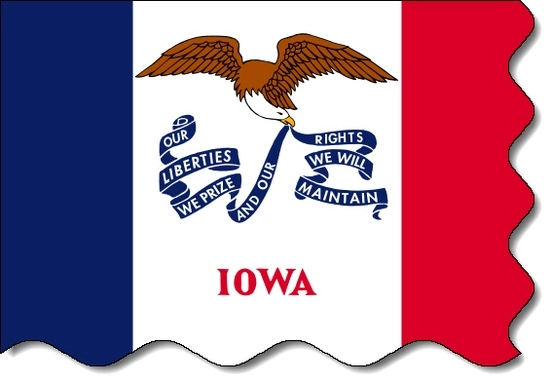
Nearby Labcorp Blood Testing facilities:
- Labcorp Center Distance: 3 m, 5359 Eastern Ave, Davenport, Scott County, IA, 52807
- Labcorp Center Distance: 4 m, 3400 Dexter Ct Ste 205, Davenport, Scott County, IA, 52807
- Labcorp Center Distance: 26 m, 2104 Cedarwood Dr Ste 202, Muscatine, Muscatine County, IA, 52761
- Labcorp Center Distance: 48 m, 2615 Northgate Dr Ste B, Iowa City, Johnson County, IA, 52245
- Labcorp Center Distance: 71 m, 2419 W. Cornerstone Ct Ste B, Peoria, Peoria County, IL, 61614
Nearby Quest Blood Testing facilities:
- Quest Center Distance: 2 m, 3524 Jersey Ridge Rd, Davenport, Scott County, IA, 52807-2223
- Quest Center Distance: 96 m, 641 Highgrove Pl, Rockford, Winnebago County, IL, 61108-2506
- Quest Center Distance: 97 m, 5901 E Riverside Blvd, Rockford, Winnebago County, IL, 61114-4935
Iowa Hormone Replacement Services
The older we get, the more important it is to go the extra mile to protect and safeguard our personal well-being. One of the most effective ways to protect your body and mind from issues related to Premature Aging and other medical conditions associated with Aging is to turn to a form of treatment known as Hormone Replacement Therapy.
The Conscious Evolution Institute provides a number of forms of HRT Therapy which are designed to alleviate or reverse medical issues associated with aging, and can increase your capacity to enjoy life and experience it to the fullest.
Iowa Low-T Treatment
One of the most sought after treatments that we provide is Testosterone Replacement Therapy. Many people think that Testosterone Deficiency is an unavoidable medical condition, and it's just something that a man has to live through, but with Testosterone HRT, it is possible to restore Testosterone Levels in the body, restoring sexual desire and potency and reducing the risk of a number of different conditions which potentially endanger your life, such as diabetes, atherosclerosis, and cardiovascular disease.
Testosterone Therapy comes in many forms, and we provide all of the most popular forms of treatment, including Testosterone Patches, Sprays, and Injections. Just call us to find out if you are eligible!
Iowa HGH Replacement Therapy
Hormone Imbalance is one of the most physiologically draining conditions that the human body can experience. HGH Deficiency is one of the more common forms of Age-Related Hormone Deficiency, and if you don't produce enough of the hormone, you are significantly more likely to experience the symptoms of premature aging.
The Conscious Evolution Institute is highly experienced in treated Human Growth Hormone Deficiency, and can both diagnose your condition and send treatment directly to your address. We offer both Sermorelin Acetate Injections and Bio-Identical HGH, both of which have been scientifically proven to restore levels of Growth Hormone in the body.
Iowa HCG Injections for Weight Loss
Over the last thirty years, the obesity rate in the United States has skyrocketed. Men and women everywhere are looking for that panacea that can combat obesity and make dieting easier. If you are someone for whom diets have simply not worked for in the past, you may be interested in the HCG Therapy options that we provide. HCG is a natural hormone which has some pretty amazing abilities when it comes to weight loss.
HCG is prescribed in combination with a form of diet known as Caloric Restriction. By taking HCG Shots and significantly reducing caloric intake, it is possible to vastly speed up the weight loss process, without leading to overwhelming feelings of hunger or draining you of valuable energy. It is possible to lose as much as a pound per day on this fantastic diet.
Major Cities in Iowa
Des Moines
Des Moines, Iowa is the largest city in the state, the center of the Iowa economy, as well as its capital. The most prominent sectors of the Des Moines economy are publishing, finance, and insurance, and the area is actually considered one of the most important locations for insurance in the country.
The city is home to a number of different corporations, including Wellmark Blue Cross Blue Shield, Ruan Transportation, and the Merideth Corporation. A number of other businesses have large presences in the area, including Monsanto, Marsh, Nationwide Mutual Insurance, and Wells Fargo. Des Moines is frequently at the top of lists for cities friendly to business.
Cedar Rapids
Cedar Rapids is the second largest city in Iowa, and is located to the north of Iowa City. Where Des Moines is known for its economy, Cedar Rapids is known for its cultural opportunity and art. There are a number of different tourist destinations for culture lovers in Cedar Rapids, including the Iowa Cultural Corridor Alliance, the Paramount Theater, the Cedar Rapids Museum of Art.
Cedar Rapids does have a strong economy, however, and among its largest employers are St. Luke's Hospital, Aegon, and Rockwell Collins. The largest sector of the Cedar Rapids economy is grain processing, and both General Mills and Quaker Oats operate out of the region.
Davenport
Davenport is the third most populous city in the state of Iowa, and is located on the eastern edge of the state, along the border of Illinois and Iowa. Davenport belongs to a metropolitan area known as the Quad Cities, which also includes Moline, Rock Island, and Bettendorf. Davenport is located about halfway between Des Moines and Chicago, placing it along an important shipping route. Davenport is also located along the Mississippi River.
The city of Davenport has a strong economy with a low cost of living and ample employment opportunities, making it one of the most livable and affordable metropolitan cities in the United States. Davenport is also known for its beautiful trails and parks, making it a fine place to live for people that thrive near nature and love the outdoors.
Sioux City
Sioux City, Iowa is located on the western border of the state, at the edge of Nebraska. Sioux City is an important transportation route of the Missouri River, because it represents the furthest north that merchant traffic can travel along the river. Sioux City is located less than 100 miles from Omaha, Nebraska. The region around Sioux City is frequently referred to as Siouxland. Among the largest employers in Sioux City are Mercy Medical Center and Tyson Fresh Meats.
Iowa City
Iowa City is the fifth most populous city in Iowa, and was the state's first capital before it was moved to Des Moines. Iowa City is located just a brief trip south from Cedar Rapids, and is the home of the University of Iowa. The Old Capital Building is actually located on the university campus, and is a popular tourist destination. Iowa City is an important city in national education, because it is home to both Pearson Assessment and Information, as well as American College Testing.
All About Davenport, Iowa Geographic Area
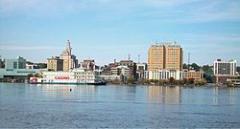
Davenport is a city located along the Mississippi River in Scott County, Iowa, United States. Davenport is the county seat of and largest city in Scott County. Davenport was founded on May 14, 1836 by Antoine LeClaire and was named for his friend, George Davenport, a colonel during the Black Hawk War stationed at nearby Fort Armstrong. As of the 2010 census, the city had a population of 99,685, making it Iowa's third-largest city. A 2011 estimate shows an increase to 100,802. As of 2012, the mayor of Davenport is Bill Gluba. Davenport is the largest of the Quad Cities. The Quad Cities also consists of neighboring Bettendorf and the Illinois cities of Moline, East Moline, and Rock Island and has an population estimate of 381,342.
Located approximately half way between Chicago and Des Moines, Davenport is on the border of Iowa and Illinois. The city is prone to frequent flooding due to its location on the Mississippi River. There are two main universities: Saint Ambrose University and Palmer College of Chiropractic, which is where the first chiropractic adjustment took place. Several annual music festivals take place in Davenport, including the Mississippi Valley Blues Festival, The Mississippi Valley Fair, and the Bix Beiderbecke Memorial Jazz Festival. An internationally known 7-mile (11 km) foot race called the Bix 7 is run during the festival. The city has a Class A minor league baseball team, the Quad Cities River Bandits. Davenport has 27 parks and over 12 miles (19 km) of recreational paths for biking or walking.
Four interstates and two major United States Highways serve the city. Davenport has seen steady population growth since its incorporation, with an exception being the 1980s, when the population decreased due to job loss. Davenport has a declining crime rate and a low rate of unemployment, and was ranked as the most affordable metropolitan area in 2010 by Forbes. In 2007, Davenport, along with neighboring Rock Island, won the City Livability Award in the small-city category from the U.S. Conference of Mayors. Notable natives of the city have included jazz musician Bix Beiderbecke and former National Football League running back Roger Craig.
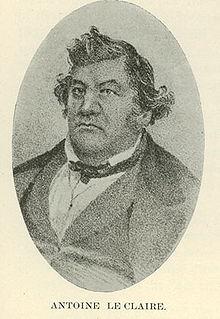
The United States acquired 828,000 square miles (2,140,000 km2) of land from France under the Louisiana Purchase in 1803. The land is in the present day central United States. Lieutenant Zebulon Pike was the first official United States representative to explore the Upper Mississippi River which runs through the newly acquired land and present-day Davenport. On August 27, 1805, Pike camped on the present day site of Davenport.
A treaty was signed in 1832 by Sauk Indian tribe chief Keokuk and United States Army General Winfield Scott to end the Black Hawk War. The future Davenport founder Antoine LeClaire served as translator. Chief Keokuk gave a generous portion of the land to Antoine's wife, Marguerite, who was the granddaughter of a Sac chief. Antoine built their home on the exact spot where the treaty was signed, as stipulated by Keokuk or he would have forfeited the land. Antoine did so, finishing the Treaty House in the spring of 1833. Davenport was established on May 14, 1836 by Antoine LeClaire, and named after his good friend Colonel George Davenport who was stationed at Fort Armstrong during the war. They city was incorporated on January 25, 1839.
Scott County was formed by an act of the Wisconsin Territorial legislature in 1837. Davenport and neighbor Rockingham both campaigned to become the county seat. The city with the most votes from Scott County citizens in the February 1838 election would become the county seat. On the eve of the election, Davenport citizens acquired the temporary service of Dubuque laborers so they could vote in the election. Davenport won the election with the help of the laborers. Rockingham supporters protested the elections to the territorial governor, on the grounds the laborers from Dubuque were not Scott County residents. The governor refused to certify the results of the election. A second election was held the following August. To avoid another import of voters, the governor set a 60-day residency requirement for all voters. Davenport was again the victor by only two votes. Because the margin of victory was so close a third election in the summer of 1840 was held. As the August election drew nearer, Rockingham residents grew tired of the county seat cause, and the efforts of Davenporters were difficult to challenge. Davenport easily won the third election. Consequently, to ensure that the county seat issue would not be played out again, Davenport built the first county courthouse.
Rock Island Railroad built the first railroad bridge across the Mississippi River in 1856. It connected Davenport to Rock Island, Illinois. This railway connection caused transportation and commerce with Chicago to significantly improve.The addition of new railroad lines to Muscatine and Iowa City, and the acquiring of other lines by the Rock Island Railroad, caused Davenport to became a commercial railroad hub.
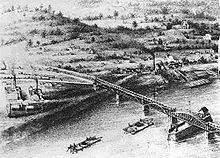
Steamboat companies saw nationwide railroads as a threat to their business and on May 6, 1856, just weeks after the bridge was completed, a steamboat captain deliberately crashed the Effie Afton into the bridge. The owner of the Effie Afton, John Hurd, filed a lawsuit against the Rock Island Railroad Company. Abraham Lincoln was the lead defense lawyer for the railroad company. The decision of the United States Supreme Court upheld the right to bridge navigable streams, therefore the bridge was allowed to remain.

Prior to the start of the Civil War, Governor Samuel J. Kirkwood declared Davenport to be Iowa's first military headquarters and five camps were set up in the city to aid the Union.
The Davenport City Hall was built in 1895 for the meager price of $100,000 ($2.79 million in 2012 dollars). Architectural journals of the time poked fun at the project due to the small amount of money budgeted. The skyline began forming in the 1920s with the building of the Kahl Building, the Parker Building, and the Capitol Theatre during an economic and building expansion.
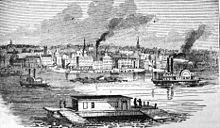
By 1932 thousands of Davenport residents were on public relief due to the Great Depression. A shantytown grew in the west end of the city along the Mississippi River. Sickness, hunger, and unsanitary living conditions plagued the area. The situation would soon change, as many citizens went to work for the Works Progress Administration and Davenport experienced a boom after World War II. Oscar Mayer, Ralston Purina, and other companies built plants in west Davenport. The Interstate highway network was brought to Davenport in 1956. By 1959 more than 1,000 homes a year were being constructed. By the late 1970s the good times were over for both downtown and local businesses and industries. The farm crisis of the 1980s negatively affected Davenport and the rest of the Quad Cities, 35,000 workers lost their jobs throughout the entire Quad Cities area. The Caterpillar plant on the city's north side closed, causing the loss of employment for many residents. The 1990s showed the beginnings of a resurgence for the city. In recent years, many renovations and building additions have occurred to revitalize the downtown area, including repairing Modern Woodmen Park, the building of the Skybridge and the Figge Art Museum. In 2011, the Gold Coast and Hamburg Historic District was named as a 2011 America's Great Place by the American Planning Association.
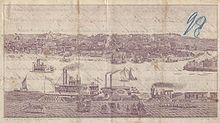
Davenport's longitude and latitude coordinates in decimal form are 41.542982, na90.590745. According to the United States Census Bureau, the city has a total area of 65.08 square miles (168.56 km2), of which, 62.95 square miles (163.04 km2) of it is land and 2.13 square miles (5.52 km2) is water. Davenport is located approximately 170 miles (270 km) west of Chicago and 170 miles (270 km) east of the Iowa state capital of Des Moines. The city is located about 200 miles (320 km) north of St. Louis, Missouri, and 265 miles (426 km) southeast of Minneapolis, Minnesota. Farmland surrounds Davenport, outside the Quad Cities area.
Davenport is located on the banks of the Mississippi River and has a maximum depth of around 30 to 40 feet (9.1 to 12 m) and is 2,217 feet (676 m) wide where the Centennial Bridge crosses it. The river flows from east to west along Davenport's banks, as opposed to its usual north to south direction. From the river the city starts to slope north up a hill, which is steep at some points. The streets of the city, especially downtown and in the central part of the town, follow a grid design. Davenport often makes national headlines when the Mississippi River floods. It is the largest city bordering the Mississippi that has no permanent flood wall or levee. Davenport prefers the open access to the river for parks and vistas over having access cut off by dikes and levees. Davenport has adopted ordinances that any new construction in the floodplain must be elevated above the 100-year-flood level or protected with walls. As a result, former mayor Phil Yerington publicly expressed the view that if they "let Mother Nature take her course, we'll all be better off". An example of a building that is elevated or flood-proofed in Davenport is the Figge Art Museum.
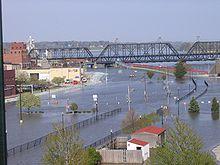
Under the Koppen climate classification, Davenport is considered to have a humid continental climate (Dfa). Summers are very warm to hot with high levels of humidity. Winters have cold temperatures and often high winds, with snow likely from November through February. Average snowfall in Davenport is 30.7 inches (780 mm) per year. January is on average the coldest month, while July is the warmest. The highest temperature recorded in Davenport was 103 °F (39 °C) on July 18, 2006. The lowest temperature, na22 °F ( na30 °C), was recorded on February 2 and February 3, 1996. Substantial weather changes frequently occur at three to four day intervals as a result of mid-latitude storm tracks, which is where low and high pressure extratropical disturbances occur.
While situated squarely in the path of Tornado Alley no devastating tornado has ever touched down in Davenport. Flooding, however, is often a problem in Davenport due to the lack of a flood wall. During the Great Flood of 1993, the water crested at 22.63 feet (6.90 m) on July 9. This is nearly 8 feet (2.4 m) above the 14.9-foot (4.5 m) flood stage. Major flooding in Davenport causes many problems. Roads in and around the downtown area, including U.S. Route 67, are closed and cause increased traffic on other city roads. The effects of major flooding can be long-lasting. For example, during the 2008 flooding, Credit Island in the city's southwest corner remained closed for 5 ½ months while crews worked on cleaning up damage and removing river debris. Duck Creek, a stream situated in Bettendorf and Davenport, is also vulnerable to flash flooding. Severe thunderstorms on June 16, 1990, created heavy flash flooding in Bettendorf and Davenport that killed four people. Another major flood happened on June 12, 2008, when severe thunderstorms caused Duck Creek to overflow its banks and flood properties and nearby streets (see Iowa flood of 2008).
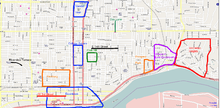
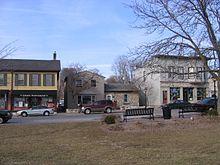
Davenport has several neighborhoods dating back to the 1840s. The original city plot was around current day Ripley and 5th Streets, where Antoine LeClaire had built his house. The city can be divided into five areas: downtown, central, east end, near north and northwest, and west end. Many architectural designs are found throughout the city including Victorian, Queen Anne, Tudor Revival, and others. Many of the original neighborhoods were inhabited by German settlers.
The east side of the city dates back to 1850 and has always contained higher end housing. The proximity and commanding view of the river kept these neighborhoods a fashionable address long after the original families departed. Lindsay Park, in The Village of East Davenport, was used as parade grounds for Civil War soldiers from Camp McClellan.
In contrast to the east side, the central and west neighborhoods originally contained many of the working class Germans who settled the town. Development on the west side started in the 1850s with extensive construction occurring in the 1870s. Housing was mostly one and a half to two story front gable American Foursquare and simplified Queen Anne style. The central Hamburg neighborhood contains the most architecturally significant residences in the old German neighborhoods. Also in central Davenport, the Vander Veer Park Historic District is a neighborhood anchored by Vander Veer Park, a large park with a botanical garden and a fountain. The park was modeled after New York City's Central Park and originally shared its name. Vander Veer is surrounded by large Queen Anne and Tudor Revival style houses that were built between 1895 and 1915. Development of the Vander Veer Park was one of the first major beautification efforts.
Today the eastern side of Davenport still contains many of the higher class houses in the city. The old Civil War parade grounds, in The Village of East Davenport ("The Village" for short), have been turned into Lindsay Park, which is surrounded by small specialty shops. West of The Village, Downtown contains the two tallest buildings in the Quad Cities: the Wells Fargo Bank Building, which is 255 feet tall, and the Mid-American Energy Building, which is 220 feet tall. Other tall buildings include the 11-story Blackhawk Hotel, the 150 foot Kahl Building and the Davenport City Hall.
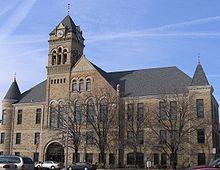
Davenport uses a mayor-council form of local government. As of 2012[update], city government consists of mayor Bill Gluba and a ten-person council. One person is elected from each of the eight wards and two at-large aldermen are elected to represent the whole city. Nonpartisan elections are held in odd-numbered years. The mayor is top elected individual for the city. The mayor's duties include running city council meetings and approves or vetoes all actions taken by the council members, and can vote in case of a tie. He or she also appoints city board members. The city council's job is to make laws and set the city budget. The city administrator, currently Craig Malin, is appointed by the mayor with confirmation by two-thirds of the council. City-wide goals through 2012 include having a financially responsible government, having a growing economy, revitalizing neighborhoods, and upgrading city infrastructure and public facilities. The establishment of Davenport as a political and government unit came in 1839, three years after the city was settled. The city was incorporated as a result of a resolution by Iowa Representative Jonathan W. Parker by special charter in the Iowa Territory on January 25, 1839. Parker was a resident of Davenport and one of six trustees elected to govern the city with Rodolphus Bennet being the first mayor. Activity for the first four months was minimal as the council failed to meet. In 1842, the city charter was amended for the first time. Changes include having six alderman replace the five trustees, dividing the city into three wards, and appointing a city clerk position to replace the recorder. The charter was amended again in 1851 to expand the city area, provide greater detail of the duties of the mayor, city council, and other officials. During the last half of the 19th century, government assumed expanding responsibilities for public welfare and public works improvements.
The city expanded police protection, even temporarily having volunteer police officers to assist the three paid officers. Fire protection was expanded in 1882, with the city's first 13 paid firefighters. Former mayor Henry Vollmer accomplished several public works achievements, including large street paving and new sub-divisions being plotted. A large city budget surplus brought the creation of the Davenport City Hall. After 1900, each mayor brought new agendas for city improvement. Waldo Becker encouraged new railroads for the city. He also promised a more business-like government, in terms of financial responsibility and to depoliticize the police department. In the mid 1920s the city established the first zoning ordinances, electrical traffic signals and street lighting. They city also expanded with the incorporation of the city of Rockingham and the establishment of the Davenport Municipal Airport.

The 2010 fiscal year budget is $199.2 million, an increase of $35 million from 2009. The city's general fund receives the largest amount of funds from property taxes, followed by service fees such as solid waste collection and swimming pool or golf course admission and 80% of its expenses go to personnel costs. The city has given a few surveys for citizens to rate the quality of life and city services. The largest department in the city is the public works department with a budget of $36.7 million. The police department is second with a budget of $22.4 million, while the fire department has a budget of $15 million. The parks department has $6.1 million, and the Davenport Public Library has a $3.8 million budget.
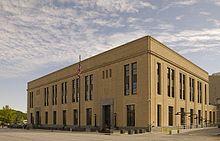
At the federal level, Davenport is in Iowa's 1st congressional district. As of 2012[update], it is represented by Democrat Bruce Braley. The two Senators are Republican Chuck Grassley and Democrat Tom Harkin. At the state level, Davenport is represented by the 41st, 42nd, and 43rd Iowa Senate districts and in the Iowa House of Representatives by the 81st, 84th, 85th, and 86th districts.
As of 2012[update], the 41st senate district covers the eastern third of the city and all of Bettendorf, Riverdale, and Panorama Park. It is more conservative then other Davenport districts being represented by a Republican since the 1970s. The district is slightly moving more liberal with an increase of 3,000 Democrats between 2006 and 2010. The district is represented by Republican Senator Roby Smith. The 42nd district covers the western third of the city along with all of Scott County that is not in Davenport, Bettendorf, Riverdale, or Panorama Park as well as western and southern rural Clinton County and is represented by Republican Senator Shawn Hamerlinck. The 43rd senate district covers the central third of the city and is represented by Democrat Joe Seng.
The 81st house district covers the eastern third of the city along with small western portion of Bettendorf. The district shares the same western boundaries as the forty-first senate district. The district is represented by Democrat Phyllis Thede. The 84th district covers the western third of the city, and has the same eastern boundary as Senate district forty-two and is represented by Republican Ross Paustian. The 85th and 86th districts are made up of the same area as the forty-third senate district. The 85th district covers the north and west-central area while the 86th district covers southern and eastern part of the senate district. Both are represented by Democrats with Jim Lykam representing the 85th and Cindy Winckler representing the 86th.
Davenport has a Federal Court House for the United States District Court for the Southern District of Iowa.
According to the 2010 United States Census estimate, the city population grew to 99,685 and the Quad Cities metropolitan area grew to 379,690. As of the 2000 census, there were 98,359 people, 39,124 households, and 24,804 families residing in the city. The population density was 1,566.5 people per square mile (604.8/km ²). There were 41,350 housing units at an average density of 658.5 per square mile (254.3/km ²). Davenport's population density is 30 times the average density of Iowa and 20 times the average density of the United States. However, it is about a third less than Des Moines and 20 percent less than Cedar Rapids, the only two cities in Iowa with higher populations than Davenport. Sioux City, the next city smaller than Davenport in population, has a density of 5 people more per square mile.
The racial makeup of the city was 83.7% White, 9.2% Black or African American, 0.4% Native American, 2.0% Asian,
The percent of all races, with the exception of white, are higher in Davenport, than Iowa averages, with the black population in Davenport four times the average of Iowa. Contrary to Iowa, only whites have a higher percent in Davenport, than in the United States as a whole. In the city the population was spread out with 26.2% under the age of 18, 10.7% from 18 to 24, 30.1% from 25 to 44, 20.9% from 45 to 64, and 12.1% who were 65 years of age or older. The median age was 34 years. For every 100 females there were 94.7 males All of which are within one percent of United States averages.
Crime in Davenport is on the decline. Violent crimes, which include robbery, rape, and assault, have fallen from 1,274 in 2002 to 712 in 2009. Murders were down from seven in 2002 to two in 2009. Rape is also down from 63 in 2002 to 49 in 2009.
Davenport's biggest labor industry is manufacturing, with over 7,600 jobs in the sector. John Deere is the second largest employer in the Quad Cities, after the Rock Island Arsenal as a whole. Deere, however, is the largest single employer, employing 7,200 workers in the Quad Cities and 948 on its north side Davenport plant. John Deere World Headquarters is located in Moline. Other large employers in Davenport and the Quad Cities include, Genesis Health System with 5,125 employees and 4,900 in Davenport, Trinity Regional Health System with 3,333, regional grocery store Hy-Vee with 3,138 and the Davenport Community School District with 2,237 employees.
Davenport is the headquarters for department store Von Maur, which has 24 stores. Davenport is also the headquarters of Lee Enterprises, which publishes fifty-five daily newspapers and more than 300 weekly newspapers, shoppers, and specialty publications, along with online sites in 23 states. As of September 2009, the unemployment rate in Davenport and the rest of the Quad Cities, had risen to 8.4%.
The median income for a household in the city is $40,378 with families earning $51,445. Males had a median income of $41,853 versus $30,002 for females. The per capita income for the city was $18,828. About 10.5% of families and 14.1% of the population were below the poverty line, including 19.2% of those under age 18 and 6.4% of those ages 65 or over.
Davenport has a lower cost of living than the national average, in 2010 the average home price was $110,000; Forbes ranked Davenport as the best metropolitan area for cost of living, up from second in 2009. CNN Money ranked Davenport as the 16th most affordable housing in the country.
The surrounding Quad Cities have a few major places of employment, including the Rock Island Arsenal, which is the largest government-owned weapons manufacturing arsenal in the United States. KONE, Inc, a large manufacturer of elevators, is located in Moline, Illinois. Alcoa, a large aluminum manufacturer, is located in Riverdale, Iowa. Other local businesses include Whitey's Ice Cream, Hungry Hobo sandwich shop, and Happy Joe's and Harris Pizza ae both local pizzerias (the former of which is also an ice cream parlor).
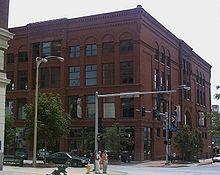
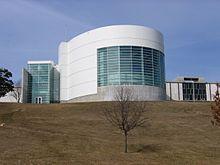
Downtown Davenport has many points of interest including the Davenport Public Library, the Davenport Skybridge, Figge Art Museum, River Music Experience, Putnam Museum, the RiverCenter/Adler Theater, Modern Woodmen Park which is home of the Quad City River Bandits baseball team and the Centennial Bridge. Entertainment venues include the Chicago, Milwaukee, St. Paul and Pacific Freight House (The Freight House).
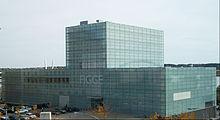
Davenport's cultural and educational institutions include the Figge Art Museum, which houses The National Center for Midwest Art and Design, and was founded in 1925 as the Davenport Municipal Art Gallery. The Putnam Museum, which was founded in 1867 and was one of the first museums west of the Mississippi River. The Quad City Symphony Orchestra, headquartered in downtown Davenport, was founded in 1915. The Davenport Public Library was opened in 1839. The German American Heritage Center is located at the foot of the Centennial Bridge.
Uptown features a few historic landmarks such as the Iowa Soldiers' Orphans' Home which took in homeless children from all of Iowa's ninety-nine counties following the Civil War and Ambrose Hall which was the original building of St. Ambrose University. Aside from landmarks, uptown contains some entertainment venues too, such as the Great Mississippi Valley Fairgrounds, which hosts fairs, stock car racing, and many other events. NorthPark Mall is the city's main shopping mall and has 160 stores. Its companion, SouthPark Mall, is located in Moline. Brady Street Stadium is home to Davenport high school and Saint Ambrose University football games. Davenport has a number of parks, including Credit Island park which has a bike path, baseball diamonds, tennis courts, and fishing along the Mississippi River. Vander Veer Botanical Park has a small botanical garden and also features a walking path, a lagoon, and a large fountain.
Bix Fest is a three-day music festival with many traditional jazz bands held in tribute to internationally renowned jazz cornetist, pianist, composer, and Davenport native Bix Beiderbecke. The festival was started in August 1971 and the Bix Beiderbecke Memorial Society was founded one year later to organize and sponsor it. 2009 was the 39th consecutive festival. In addition to the Bix Fest, the Wells Fargo Street Fest features live music, food, and vendors.
The annual Bix 7 is a 7-mile (11 km) road race held in late July in Davenport. The race was founded in 1975 by a resident of Bettendorf, Iowa, who wanted to bring to the Quad Cities some of the excitement he felt when he ran his first Boston Marathon. The first race had 84 participants, but today 12,000 to 18,000 runners take part. In late July or early August the six-day Great Mississippi Valley Fair features major grandstand concerts, carnival rides, attractions, and food vendors. Sturgis on the River is a large annual gathering of motorcycles which includes bands and food vendors. Another big festival that takes place in Davenport is The Great Mississippi Valley Fair. Others include Stirgus By The River, River Roots Live, Beaxu Arts Fair and many others.
Davenport has three sister cities. Kaiserslautern, Germany, became a sister city on June 10, 1960. The coastal city of Ilheus in Bahia, Brazil, became Davenport's sister city on January 31, 2005. Davenport and County Carlow, Ireland, became sister cities on September 26, 2006.
Davenport (along with neighboring Rock Island, Illinois), won the 2007 City Livability Award in the small-city category from the U.S. Conference of Mayors. Tom Cochran, Executive Director of the Conference, stated that the award "gives the Conference a chance to highlight mayoral leadership in making urban areas safer, cleaner and more livable." The award acknowledges achievements from the RiverVision plan of Davenport and Rock Island.

Davenport and the Quad Cities are home to many sports teams. The Quad Cities River Bandits baseball team play games at Downtown Davenport's Modern Woodmen Park. The i wireless Center in Moline is home to the Quad City Mallards hockey team. The Quad Cities Riverhawks are a Premier Basketball League team. They play their home games at Wharton Field House on the old Marycrest International University campus. Davenport high schools are in the Mississippi Athletic Conference for sports.
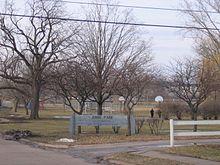
Davenport has over forty parks or recreational trails. Major parks include Credit Island, which is a 450-acre (1.8 km2) park in southwest Davenport located alongside the Mississippi River. Fejervary Park contains a pool and children's zoo and has had approximately 20,000 visitors each year since 1996. Junge Park is situated along the Duck Creek Parkway and includes baseball and softball fields, sand volleyball, and basketball courts. LeClaire Park is located right on the banks of the Mississippi River next to Modern Woodmen Park. LeClaire Park hosts many summer events including River Roots Live and Ribfest. Bands for the Bix Fest play in the park each July. Vander Veer Botanical Park welcomes approximately 25,000 visitors to continuous floral shows.
The city features two recreational trails for biking or walking. Duck Creek Parkway extends from Emeis Park in west Davenport 8.26 miles (13.29 km) east to Bettendorf along Duck Creek. Riverfront Parkway extends 4.75 miles (7.64 km) along the Mississippi waterfront from Credit Island to Bettendorf. Both these trails continue into Bettendorf. Plans are being discussed to connect the two trails in Riverdale. Three public golf courses are offered in the city. For river-related activities, The Channel Cat boat offers rides across the river and has two stops in Iowa and three stops in Illinois and connects the bike paths that each state has on its river front.

There are two major daily newspapers in Davenport. The Quad-City Times is based out of Davenport and The Dispatch/Rock Island Argus is based out of Moline. An alternative free newspaper, the River Cities Reader, is published in Davenport. All four major television networks have stations in the area, including KWQC (NBC) and KLJB (Fox) in Davenport. WHBF (CBS) is located in Rock Island and WQAD (ABC) is in Moline.
The Quad Cities ranks as the 97th largest market for television[100] and the 147th largest market for radio.[101] Radio station WOC made its local broadcasting debut on February 18, 1922. It was the second licensed station on the air.[102] In 1933 WOC hired future president Ronald Reagan as a staff announcer.[102]
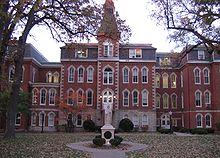
Davenport public schools serve nearly 17,000 students in the communities of Davenport, Blue Grass, Buffalo, and Walcott. The Davenport Community School District is the second largest school district in Iowa.[103] Davenport has three public high schools: Central, West, and North and one private high school: Assumption. There are six public intermediate schools and 23 public elementary schools.[104] One of the intermediate schools, Sudlow was named after Phebe Sudlow, the first female public school superintendent in the United States.[105] She was superintendent for Davenport schools from 1874 ae1878.[105] The high schools are part of the Mississippi Athletic Conference for sports. The city has four colleges and universities: Palmer Chiropractic College, which is the first chiropractic school and the location of the first chiropractic adjustment in the world,[106][107][108] Saint Ambrose University, Kaplan University, and Hamilton Technical College. Marycrest International University was a university in Davenport from 1939 to 2002, when it closed and became senior citizen housing.[109]
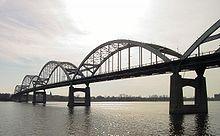
Three interstate highways serve Davenport: Interstate 80, Interstate 280, and Interstate 74. Interstate 88 serves the Illinois Quad Cities and runs east to Chicago. U.S. Route 6, U.S. Route 61, and U.S. Route 67 also go through Davenport; U.S. 67 crosses over to Illinois via the Rock Island Centennial Bridge. Davenport is connected to the Illinois side of the Quad Cities by a total of three bridges across the Mississippi River. The Government Bridge and the Centennial Bridge connect Downtown Davenport with the Rock Island Arsenal and downtown Rock Island, respectively. The I-280 Bridge connects the western edge of Davenport with the western edge of Rock Island.
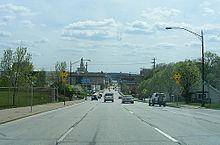
Other highways include Iowa Highway 22, which is on the city's southwest side, and Iowa Highway 130, which runs along Northwest Boulevard on Davenport's north edge. For air travel, Davenport Municipal Airport ae located adjacent to the city's northern city limits ae serves smaller aircraft, and is the home of the annual Quad City Airshow. The Quad City International Airport across the river in Moline, Illinois, is the closest commercial airport. Major railroads include the Iowa Interstate Railroad and the Iowa, Chicago and Eastern. Two national U.S. recreation trails intersect in Davenport: the Mississippi River Trail and the American Discovery Trail.
Amtrak currently does not serve Davenport or the Quad Cities. The closest station currently is about 50 miles (80 km) away in Galesburg, Illinois. Once the Moline, Illinois Amtrak station is completed sometime by 2014. In 2008, the two current United States Senators from Iowa, Tom Harkin and Chuck Grassley, Illinois Senator Dick Durbin, and former Senator Barack Obama sent a letter to Amtrak asking them to begin plans to bring rail service to the Quad Cities.[110] In October 2010, a $230 million federal fund was announced that will bring Amtrak service to the Quad Cities, with a new line running from Moline to Chicago. They hope to have the lined completed in 2015, and offer two round trips daily to Chicago.[111] Greyhound Lines/Burlington Trailways bus service has a station in Davenport. The building is shared with the local Davenport Citibus.[112] Davenport does not have any river ports.
Davenport has an infamous "truck-eating bridge".[113] The bridge, or rather three bridges, is a set of railroad bridges that cross over north and southbound U.S. Route 61 and another street. Every year an average of 12 semi trucks hit the bridge, usually causing massive damage to the trucks.[113] The bridges, made out of iron, steel, and concrete, are rarely damaged.[113]
Public transit appeared in Davenport in 1969 when the city created a City Transit Authority.[112] The authority at first provided monetary support to Davenport City Lines Bus Company, which was a privately owned company. After a few years the city purchased the Davenport City Lines and placed the operation of public transportation under the jurisdiction of the City's Department of Municipal Transportation. Today, CitiBus is a division of the Department of Public Works. CitiBus has a total of 20 vehicles and covers approximately 30 square miles (78 km2) of the city. CitiBus connects with both Bettendorf Transit and the Illinois Quad Cities mass transit system, MetroLINK.[112] In 2007 Citibus saw a ridership of 1,022,815 customers. Ridership as of September 2008 had grown to 1,045,000 due in part to high gas prices.[114]

Electricity to Davenport, and the rest of the Iowa Quad Cities, is provided by MidAmerican Energy Company. Water is provided by the Mississippi River and is treated by the Iowa American Water Company. The water treatment facility is located in southeast Davenport.
Davenport is served by two hospitals: Genesis Medical Center East ae Rusholme Street and Genesis Medical Center ae West Central Park Avenue part of the Genesis Health System. Together the facilities, along with two other facilities outside Davenport have 665 beds.[115] The hospitals employ more than 600 physicians and 5,000 staff members.[115] The American Nurses Credentialing Center, awarded Genesis Medical Center the Magnet designation for excellence in nursing services.[116] Fewer than three percent of hospitals receive this honor.[116]
Notable Davenporters include jazz musician Bix Beiderbecke, after whom the Bix 7 road race and jazz festival are named.[117] The artist Isabel Bloom was raised in Davenport; she is the creator of decorative concrete figurines that bear her name.[118][119] Sports figures born in Davenport include NFL running back Roger Craig and former middleweight boxing champion Michael Nunn.[120][121] Other natives include the aviation pioneer Samuel Cody, actors Stuart Margolin, Lara Flynn Boyle, Sue Lyon and Linnea Quigley.[122][123][124]Otto Frederick Rohwedder, the inventor of mass-produced sliced bread, grew up in Davenport.[125]
Word Count: 6541





